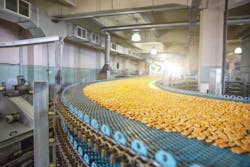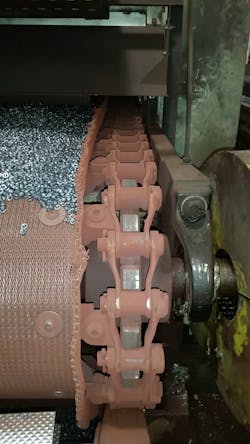Conveyor OEMs: “Shaped” Wire Belt Lasts Up to 8 Times Longer
For conveyor OEMs, the demanding processes of some customers, such as food processors and manufacturers that use heat treating, can be notoriously hard on their conveyor belting, which can lead to excessive replacement and production downtime as well as reliability issues.
Fortunately, for conveyor OEMs looking to enhance longevity and reliability for such customers, industry innovation in the form of an engineered, “shaped” wire belt has minimized these challenges. This enables them to offer their breaded food processing customers as well as manufacturers that use heat treating a belting design that vastly prolongs usable life with increased strength and decreased stretch—which dramatically curtails production downtime and replacement costs.
In addition, for those catering to the needs of breaded food processors, this approach enables a significantly greater amount of surplus coating, such as batter, breading or spice, to fall through the wire belt openings to be re-used. As a result, this lowers production cost even further.
Overcoming Traditional Limitations
Food processing plant customers that use conveyors to bread or batter products such as poultry, pork, seafood, vegetables, and cheese require wire belting that can withstand the rigors of the process. However, traditional round balance weave belting has changed little in 100 years and is notorious for requiring replacement in as little as a week, causing costly production downtime and excess wasted product.
Savvy conveyor OEMs understand the need to offer not only their breaded food processing plant customers, but also other conveyor wire belts of greater robustness.
“If the conveyor’s wire belt gets plugged up with batter or breading or if it gets stretched out, you usually have to replace the whole belt,” says a maintenance supervisor who has worked in various food processing facilities serving wholesale and retail markets for over 30 years. As such, he has overseen conveyor belt installation and replacement and maintained equipment for a wide range of food products including breaded or battered chicken, fish, cheese, and vegetables.
The maintenance supervisor describes the traditional wire belt longevity challenge as he observed it while working at a food manufacturer of breaded appetizers.
“The sprockets where the belt goes around the drive would build up with breading. The breading would stretch the belt until it broke, usually in about a week. So, production was often stopped for at least 45 minutes to change out the belt,” he explains.
Additionally, in the food processing industry, after coating a product, too often excess breading, batter or seasoning gets “carried over” to the next processing station (often a fryer) and wasted—instead of falling through openings in the wire belt and then reused.
Resolving the Core Issues
As conveyor OEMs know, conventional round wire belt has been the industry standard for generations. However, the geometry of the wire itself contributes to the problem.
Traditional round and even top-flattened wire belt presents a rather narrow opening for any given wire gauge, which makes it more difficult for excess breading or batter to fall through the opening to be reused. Such belting is usually predisposed to “blinding” of its openings. This can hasten breading or batter build-up and the clogging of conveyor sprockets, leading to belt stretch and the need for premature replacement.
In testing, typical round and top flattened conveyor wire belts have been observed to stretch approximately 7%. Such belt stretch is typically the biggest cause for failure on sprocket-driven conveyor belts. When the belt stretches, the sprocket teeth do not engage evenly and will begin to jump the teeth, damaging the belt and sprockets in short order.
Even though many producers of conveyor wire belts simply import semi-finished product and finish it domestically, at least one U.S.-based manufacturer has gone to the root of the problem.
The solution for conveyor OEMs and their exacting customers, including food processing and manufacturers that use heat treating is to engineer “shaped” wire that is designed to provide more strength and open area in wire belt of a given diameter. This not only significantly prolongs its usable life up to 8 times or more, but also in the case of food processors facilitates the cost-effective reuse of the excess breading, batter, and seasoning that falls through the wire openings.
As an example, one engineered wire belt, called Sidewinder by Lancaster, PA-based Lumsden Belting, a manufacturer of metal conveyor belts for industries such as food processing, compresses and expands wire so it is taller than it is wide with flat sides.
To begin with, the patented side flattened wire’s “I-beam” design provides 3 times greater structural support for food industry products compared to standard round wire. The added height of the wire also provides a long wear life without needing heavier wire. Together, the design limits belt stretch to only 1 to 2%.
When the food manufacturer of breaded appetizers turned to the shaped wire belt, the results dramatically improved longevity.
“Where the traditional belt would last about one week, the shaped Sidewinder belt would last about two months,” says the maintenance supervisor.
Later, at processing plants at different companies processing breaded chicken and fish, he says the shaped wire similarly enhanced usable belt life.
“The results were excellent, and the heavier the breading or batter the more the design extended belt life,” he says.
In terms of design, shaping the wire into taller thinner spirals than standard enhances the open area. So, food processors can utilize the same wire gauge of their current belt and gain more open area while lasting longer. Or they can increase the wire diameter to make an even stronger belt without sacrificing the critical open area.
The flattened sides of the wire also reduce the “carry over” issue, which otherwise invariably leads to coating product waste. With a minimum curvature at the top and bottom of each wire loop, there is less surface area for expensive coating to contact. So, the flat sides of the shaped spiral allow any spare coating to fall through without clogging openings.
The same approach also helps conveyor OEMs serving automotive, aerospace, or heavy equipment manufacturers that use heat treating because the stronger ‘shaped’ wire belt similarly stands up to the rigors of that process. Heat treating can reach temperatures up to 2,400°F and vary from a few seconds to 60+ hours, so requires very robust conveyor belting.
Heat treating is essential to improve the properties, performance, and durability of metals such as steel, iron, aluminum alloys, copper, nickel, magnesium, and titanium. This can involve conveying to hardening, brazing, and soldering, as well as to sintering furnaces, carburizing furnaces, atmosphere tempering furnaces, and heat processing in annealing and quenching furnaces. Parts treated can range from bearings, gears, axles, fasteners, camshafts, and crankshafts to saws, axes, and cutting tools.
Although heat-resistant wire belting is available, repeated thermal cycling between heating, soaking, and cooling while carrying substantial loads can continually weaken its structure until it fails. Traditional round wire belts and even top-flattened wire belting are also prone to belt stretch and premature replacement, particularly under high heat treatment temperatures.
For conveyor OEMs aiming to offer their manufacturing customers that use heat-treating a product with greater reliability, “shaped” wire-like Lumsden’s Sidewinder is designed to provide more strength in wire belts of a given diameter that can better withstand high heat processing.
The innovative design is significantly extending the usable life of wire-belt conveyors used in a variety of heat-treat processes. This ranges from hardening, brazing, and soldering to sintering, carburizing, and atmosphere tempering furnaces. It is also prolonging wire-belt conveyor life in secondary powder metal processes used to improve hardness and other mechanical properties. In this vein, it could be used in a mesh belt sintering furnace, where compacted parts are placed in a controlled atmosphere and heated. It could also be used in processes such as quench and temper, case carburizing, and induction hardening.
When heat treatment is used for hardening, followed by rapid cooling submerged in a medium such as oil, brine, or water, the shaped wire belt also enhances the open area for the same gauge wire. This reduces residue build-up and eases cleaning while minimizing drag.
Although the cost of the shaped wire belt is slightly more than traditional round wire, conveyor OEMs who offer it to their customers in food processing, as well as manufacturers that use heat treating, can offer significantly more value, with substantial gains in lifespan and production uptime.


